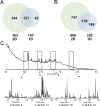Two-Dimensional Separation Using High-pH and Low-pH Reversed Phase Liquid Chromatography for Top-down Proteomics
- PMID: 31097918
- PMCID: PMC6516780
- DOI: 10.1016/j.ijms.2017.09.001
Two-Dimensional Separation Using High-pH and Low-pH Reversed Phase Liquid Chromatography for Top-down Proteomics
Abstract
Advancements in chromatographic separation are critical to in-depth top-down proteomics of complex intact protein samples. Reversed-phase liquid chromatography is the most prevalent technique for top-down proteomics. However, in cases of high complexities and large dynamic ranges, 1D-RPLC may not provide sufficient coverage of the proteome. To address these challenges, orthogonal separation techniques are often combined to improve the coverage and the dynamic range of detection. In this study, a "salt-free" high-pH RPLC was evaluated as an orthogonal dimension of separation to conventional low-pH RPLC with top-down MS. The RPLC separations with low-pH conditions (pH=2) and high-pH conditions (pH=10) were compared to confirm the good orthogonality between high-pH and low-pH RPLC's. The offline 2D RPLC-RPLC-MS/MS analyses of intact E. coli samples were evaluated for the improvement of intact protein identifications as well as intact proteoform characterizations. Compared to the 163 proteins and 328 proteoforms identified using a 1D RPLC-MS approach, 365 proteins and 886 proteoforms were identified using the 2D RPLC-RPLC top-down MS approach. Our results demonstrate that the 2D RPLC-RPLC top-down approach holds great potential for in-depth top-down proteomics studies by utilizing the high resolving power of RPLC separations and by using mass spectrometry compatible buffers for easy sample handling for online MS analysis.
Keywords: 2D separation; Top-down proteomics; proteoform.
Figures






Similar articles
-
Development of an Online 2D Ultrahigh-Pressure Nano-LC System for High-pH and Low-pH Reversed Phase Separation in Top-Down Proteomics.Anal Chem. 2020 Oct 6;92(19):12774-12777. doi: 10.1021/acs.analchem.0c03395. Epub 2020 Sep 1. Anal Chem. 2020. PMID: 32857493 Free PMC article.
-
[Comparing nanoflow reversed-phase liquid chromatography-tandem mass spectrometry and capillary zone electrophoresis-tandem mass spectrometry for top-down proteomics].Se Pu. 2019 Aug 8;37(8):878-886. doi: 10.3724/SP.J.1123.2019.05001. Se Pu. 2019. PMID: 31642259 Free PMC article.
-
RPLC-RPLC-MS/MS for Proteoform Identification.Methods Mol Biol. 2022;2500:31-42. doi: 10.1007/978-1-0716-2325-1_4. Methods Mol Biol. 2022. PMID: 35657585 Free PMC article.
-
[Applications of high performance liquid chromatography-mass spectrometry in proteomics].Se Pu. 2024 Jul;42(7):601-612. doi: 10.3724/SP.J.1123.2023.11006. Se Pu. 2024. PMID: 38966969 Free PMC article. Review. Chinese.
-
Top-Down Mass Spectrometry: Proteomics to Proteoforms.Adv Exp Med Biol. 2016;919:171-200. doi: 10.1007/978-3-319-41448-5_8. Adv Exp Med Biol. 2016. PMID: 27975217 Review.
Cited by
-
PEPPI-MS: Polyacrylamide-Gel-Based Prefractionation for Analysis of Intact Proteoforms and Protein Complexes by Mass Spectrometry.J Proteome Res. 2020 Sep 4;19(9):3779-3791. doi: 10.1021/acs.jproteome.0c00303. Epub 2020 Jul 11. J Proteome Res. 2020. PMID: 32538093 Free PMC article.
-
Metabolic and proteomic analysis of a medicinal morel (Morchella elata) from Western Himalayas, Kashmir.Metabolomics. 2025 Feb 22;21(2):34. doi: 10.1007/s11306-025-02222-6. Metabolomics. 2025. PMID: 39987365
-
Deep Intact Proteoform Characterization in Human Cell Lysate Using High-pH and Low-pH Reversed-Phase Liquid Chromatography.J Am Soc Mass Spectrom. 2019 Dec;30(12):2502-2513. doi: 10.1007/s13361-019-02315-2. Epub 2019 Nov 21. J Am Soc Mass Spectrom. 2019. PMID: 31755044 Free PMC article.
-
Ion-Ion Proton Transfer and Parallel Ion Parking for the Analysis of Mixtures of Intact Proteins on a Modified Orbitrap Mass Analyzer.J Am Soc Mass Spectrom. 2019 Oct;30(10):2163-2173. doi: 10.1007/s13361-019-02290-8. Epub 2019 Aug 7. J Am Soc Mass Spectrom. 2019. PMID: 31392699 Free PMC article.
-
Development of an Online 2D Ultrahigh-Pressure Nano-LC System for High-pH and Low-pH Reversed Phase Separation in Top-Down Proteomics.Anal Chem. 2020 Oct 6;92(19):12774-12777. doi: 10.1021/acs.analchem.0c03395. Epub 2020 Sep 1. Anal Chem. 2020. PMID: 32857493 Free PMC article.
References
Grants and funding
LinkOut - more resources
Full Text Sources
Other Literature Sources
